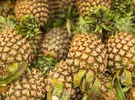 Foodservice demand for pineapple continues to be down, largely in part due to school closures.
Foodservice demand for pineapple continues to be down, largely in part due to school closures.
“Pineapples are one of the strongest items in foodservice,” says Victor Wilcox with First Quality Produce in Fresno, CA. “But demand is low. It’s a main item for a lot of school districts. But because most of the country isn’t back in person, they’re not spending the premium to serve pineapple.”
Other factors are also working their way into pineapple demand as well. “There’s a big emphasis from the USDA to ‘Buy American’ and pineapple for the most part isn’t grown domestically,” says Wilcox. “It’s a bit more challenging to get pineapple to the consumer in that sense.”
Steady supplies
Supplies of pineapple are currently coming from Costa Rica and South America. “We pretty much deal with Costa Rica year-round and supplies are usually steady,” he says. “There are a couple of times a year—in October and in February/March—where hurricane season threatens the crops though.” At the same time, some Hawaiian pineapple is also being shipped but that largely makes its way directly to retail.
Meanwhile, while retail demand for pineapple is good, there’s a change at retail too “There are a lot more retail customers looking to move into fresh-cut pineapple—so premade spears or chunks in clamshells and containers,” notes Wilcox. “This demand has slowly been building.”
As for pricing on pineapples, Wilcox says it is somewhat higher than historical pricing, which could be related to retail demand. “There are also a lot more consequences from COVID-19—logistical consequences and picking consequences,” he says. “For instance, the farming operations might not be able to have people pick as long or have fewer pickers. It all trickles down.”
For more information:
Victor Wilcox
First Quality Produce
Tel: +1 (559) 442-1932
victor@firstqualityproduce.com
http://www.firstqualityproduce.com/
